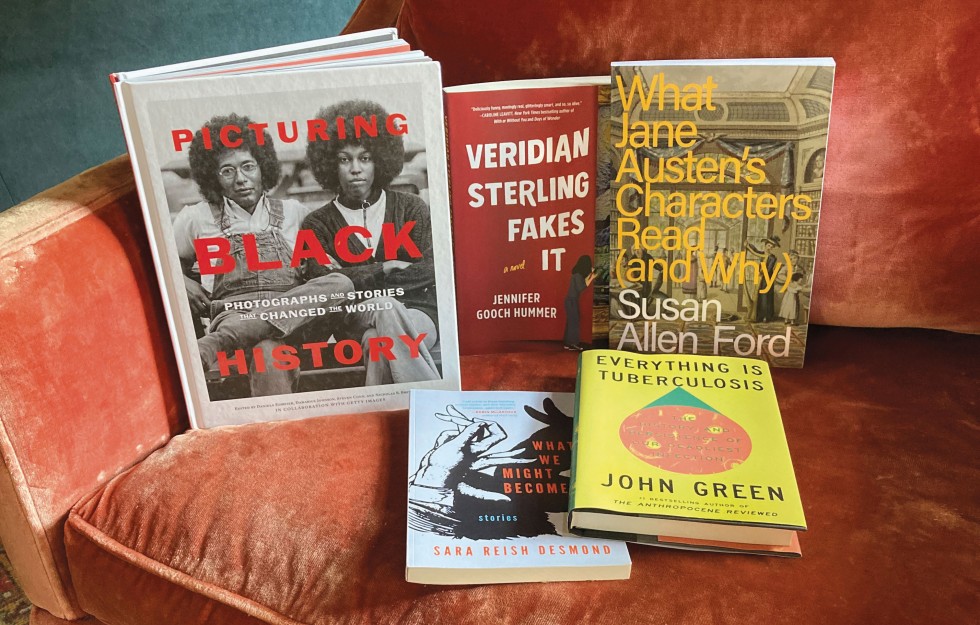Preserving Our Place
How the Philander Chase Conservancy is protecting Kenyon’s rural setting, one farm at a time.
Read The StoryExplore new releases from members of the Kenyon community.

EDITED BY DANIELA EDMEIER ’15, DAMARIUS JOHNSON, STEVEN CONN, AND NICHOLAS B. BREYFOGLE
They say a picture’s worth a thousand words, and this expansive collection, “Picturing Black History: Photographs and Stories that Changed the World,” has the best of both. From the earliest portraits of Black life in America to images of Black political, cultural and educational life from the past century, this collection of photographs and accompanying essays is a powerful spotlight on resistance and resilience. (Abrams)
BY SUSAN ALLEN FORD ’77
Like her most ardent readers, Jane Austen was a bibliophile — an identity she passed on to many of her characters. “What Jane Austen’s Characters Read (and Why)” explores the texts within Austen’s texts, and how they were influenced by her voracious tastes in books, as well as readers’ responses to her novels. Austen fans will be delighted by the surprising ways her characters’ tastes in books illuminate previously unconsidered details in her timeless texts. (Bloomsbury)
BY SARA REISH DESMOND ’98
The best short-story collections are those where each story has embodied characters in a world unto themselves. As you read, the characters across stories — through their fears and yearnings — feel in conversation with one another. “What We Might Become” does that masterfully. Whether the character is a child whose father has returned from war or a social outcast with robotic body parts, the characters are hungry, searching and grieving — all hoping to exit the liminal space of their existence to find belonging. (Cornerstone Press)
BY JENNIFER GOOCH HUMMER ’87
Recent art school grad Veridian Sterling has one unique talent: She can replicate Van Gogh paintings with exacting perfection, a skill she uses to create a forgery so good she hopes it’ll fool the most critical eyes and get her some much-needed money to support her struggling mother. An art heist full of twists and turns — and even a little romance — “Veridian Sterling Fakes It” is a fast-paced, fun romp through the art world. (Lake Union Publishing)
BY JOHN GREEN ’00
John Green rose to literary prominence through his bestselling young-adult novels, and for those who don’t follow him on social media, his second nonfiction book, “Everything Is Tuberculosis,” might seem like a U-turn. But Green first became curious about tuberculosis in 2019 while traveling in Sierra Leone with Partners in Health. There, he met and befriended Henry, a young tuberculosis patient at Lakka Government Hospital whose story is at the center of this book. And Green has since made it his mission to raise awareness and advocate for increased access to treatment for this curable disease that is killing 1.5 million people every year. “Everything Is Tuberculosis” is as riveting as it is timely. (Penguin Random House)
• Emily King ’87, “At Ease: The Guide to a Smooth & Successful Military Transition”
• Conrad Kohrs Jr. ’81, “Rainbownesia: A Micronesian Dream (Outta’ Nowhere)”
• Ransom Riggs ’01, “Sunderworld, Vol. I: The Extraordinary Disappointments of Leopold Berry”
• Ben Jamieson Stanley ’12, “Precarious Eating: Narrating Environmental Harm in the Global South”
• The Rt. Rev. William E. Swing ’58, “God and Nuclear Weapons: Reflections at the End of the Atomic Age”
• Andrew Welsh-Huggins ’83, “Sick to Death” and “The Mailman”
Editor’s Note: Have you published a book in the past year? Email editor@kenyon.edu and tell us about it.
How the Philander Chase Conservancy is protecting Kenyon’s rural setting, one farm at a time.
Read The StoryIn a freewheelin’ conversation, Jay Cocks ’66 H’04 talks with Chris Eigeman ’87 about his Oscar-nominated…
Read The StoryDiscovering Kenyon’s Latin and Greek inscriptions, long hidden in plain sight.
Read The Story